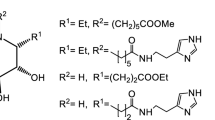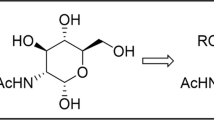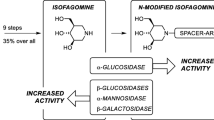Abstract
Background
Phenylazonaphtol-β-D-O-glycosides are alternative substrates for the detection of enzymatic activity of β-glycosidases which are involved in various important processes. These azoic compounds are currently exploited as prodrugs for colonic disease due the presence of β-glycosidase activity in the gut flora and therefore allowing the release of the drug at the specific site.
Results
Phenylazonaphtol-β-D-O-glucoside 3a and galactoside 3b were prepared via diazonium salt conditions under weak acidic conditions which do not compromise the O-glycosidic bond stability, by coupling reaction between 2-naphtol sodium salt with aminoglycosides 1a and 1b. The resulting phenylazonaphtol glycosides 2a and 2b were deprotected affording the phenylazonaphtol glycosides 3a and 3b in quantitative yield. The galactoside glycoside 3b was assayed as substrate for in vitro β-galactosidase enzymatic activity showing strong absorbance after releasing of the azoic chromophore. Also, docking studies were performed to determine the best pose as well as the interactions between the ligand and the residues located at the active site.
Conclusions
The methodology developed for synthesizing the phenylazonaphtol glycosides described proved to be convenient for generating azoic functionalities in the presence of glycosidic bonds and the glycosides suitable as alternative substrates and potentially useful prodrugs in the treatment of colonic diseases.

Similar content being viewed by others
Background
β-glycosidases are hydrolytic enzymes involved in a number of important processes such as defense mechanism, growth regulation [1], gene markers in transgenic plants [2], and prodrugs [3]. The most commonly used substrates for the histochemical localization of β-glycosidases contain the 5-bromo-4-chloro-3-indolyl chromophore attached to most of the known monosaccharides through an O-glycosidic bond [4]. After enzymatic hydrolysis, the water soluble indoxyl intermediate must undergo an oxidative dimerization to produce a blue precipitate. However, in some cases before dimerization occurs to produce the indigo dye, some diffusion takes place, producing false positives at some regions in cells lacking enzymatic activity [5]. In addition, phenylazonaphtol glucosides have been synthetically prepared and tested in transgenic plants containing the β-glucuronidase activity which is a widely used gene marker. A comparative test between the commercially available glycosidic indoxyl substrates with the alternative phenylazonaphtol glucuronides resulted in partial diffusion for the indigo dye and no detectable diffusion for the phenylazonaphtol chromophore [6, 7].
On the other hand, glycosides when attached to pharmacologically active substances can be used as prodrugs for improving availability, stability, and particularly for specific delivery of the active compound at the target organ. For instance, steroids, antitumor, and anti-inflammatory compounds have been attached to glycosides and evaluated as specific delivery prodrugs [8]. Also, azoic β-glycosides provided to be useful as prodrugs particularly against colitis, Crohn's disease, and colorectal cancer since the delivery at colon level might be achieved by the action of azo-reductase or glycosidase present at the colonic microflora [9].
Due the potential usefulness of phenylazonaphtol glycosides in processes mentioned above, we developed a methodology for preparing phenylazonaphtol glycosides under weak acidic conditions and the resulting azoic glycosides evaluated as β-galactosidase substrates with potential application as prodrugs for colon diseases.
Methods
The preparation of the phenylazonaphtol glycosides 3a and 3b was achieved according to Scheme 1 consisting in the coupling reaction between 2-naphtol in the sodium salt form with 4-aminophenyl tetracetyl glycopyranoside [10–12] 1a and 1b under modified diazonium salt condition, which is mainly the use of acetic acid instead of stronger acids, with sodium nitrite at 0°C to produce the diazonium salts which was condensed in situ with 2-naphtol sodium salt providing the corresponding phenylazonaphtol tetracetyl glucopyranoside 2a and 2b. Final removal of the acetate protecting groups under Zemplen conditions provided the target phenylazonaphtol glycosides 3a and 3b as a reddish solid in 60% yield.
Scheme
The beta galactosidase assay. β-galactosidase (2 mg; 2.1 U/mg) was suspended in 0.8 mL of buffer containing 0.06 M Na2HPO4, 0.04 M NaH2PO4, 0.01 M KCl, 0.001 M MgSO4, and 1 mM DTT, pH 7.0, and then incubated with glycoside 3b (4 mg; 9.3 × 10-3 mM) in a mixture of 50 mM acetate buffer with pH 5.0 (0.5 mL) and methanol (0.5 mL) at 37°C for 3 h. The reaction was stopped by adding 0.5 mL 1 M Na2CO3. The amount of the released phenylazonaphtol chromophore was measured spectrophotometrically at 410 and 455 nm [13].
Results and discussion
The deprotected glycoside 3b was tested as substrate for the detection of glycosidase activity using commercial Escherichia coli β-galactosidase. Thus, the hydrolytic activity resulted in the cleavage of the glycosidic linkage, releasing the phenylazonaphtol chromophore which is observed as an intense reddish color with absorption at 410 and 455 nm, as it is observed in the absorption graphic (Figure 1) and as observed in the vials (Figure 2).
Docking studies
The active site architecture showing the interactions between the phenylazonaphtol galactoside 3b and E. coli β-galactosidase pocket was performed using AutoDock 4.2 [14] and Chimera [15] software packages as visualization system. The protein assigned for the docking analysis was E. coli β-galactosidase (PDB IDs: 1JYN), and the residues chosen were Asn102, Asp201, Asn460, His418, Glu461, Glu537, His540, Phe 601, and Trp999 which have been described to participate in the interactions with its natural substrate lactose [16]. β-galactosidase is a retaining glycosidase with a double displacement mechanism, and its interactions with the ligand proceed with participation of water and the ions Mg2+ and Na1+ within the catalytic cavity [17]. The docking analysis was performed to find the minimized conformations according to the docking protocols which use the Lamarckian Genetic Algorithm for searching the most favorable ligand-protein complex interactions. Thus, as a result of the docking analysis, we found the minimized conformer with the galactose moiety positioned toward the active site having a binding energy of -11.62, showing hydrogen bond interactions of C-3 and C-4 hydroxyl groups of galactoside moiety with Glu461 residue, in agreement with those reported for the natural substrate lactose [16] (Figure 3).
The ribbon representation was also analyzed by using the chimera visualizing system to show the region of the cavity and the residues involved in the interaction with the substrate 3b (Figure 4).In addition, the surface representation shows that the galactopyranoside moiety is embedded into the pocket interacting with the residues while the azoic chromophore is pointed out toward the pocket exit as shown in Figure 5.
Experimental
All the reagents were purchased from Aldrich Chemical Co. (St. Louis, MO, USA) except HBr/acetic acid which was purchased from Fluka Chemical Co. (Buchs, Switzerland). Column chromatography was performed on silica gel with a 70-230 mesh, and thin-layer chromatography on Kieselgel, both from Merck Co. (Darmstadt, Germany), which was used as a detection system. A cerium sulfate solution followed by heating on hot plate. Infrared (IR) spectra were obtained on Perkin-Elmer spectrometer (Waltham, MA, USA); nuclear magnetic resonance (NMR) spectra were recorded on Varian 300-MHz spectrometer (Palo Alto, CA, USA) and Bruker 500 MHz (Karlsruhe, Germany). Mass spectrum (MS) spectra were obtained using a Hewlett-Packard 5989A (Palo Alto, CA, USA). Optical rotations were measured with a Perkin-Elmer 341 polarimeter at 23°C. Enzyme galactosidase was purchased from Sigma Chemical Company (St. Louis, MO, USA).
1-[(4-tetra-O-acetyl-β-D-glucopyranosyloxy phenyl)azo]-2-naphtol (2a)
Compound 1a (0.543 g, 1.23 mmol) was dissolved in 8 mL of THF, and the flask was cooled to 0°C. After the addition of sodium nitrite (85 mg, 1.23 mmol) and 0.5 mL of acetic acid/H2O (1:1, v/v), the reaction was kept under ice-bath temperature with stirring for 15 min. 2-naphtol sodium salt dissolved in 5 mL of THF/H2O (1:1, v/v) was added dropwise in another flask, and the reaction was kept at 0°C with stirring for 30 min, allowing the reaction to reach room temperature and stirred for another 60 min. The solvent was removed under vacuo, diluted with CH2Cl2 (30 mL) and washed with cold 2 N NaOH solution (3 × 15 mL) and water (20 mL). The organic phase was dried over anhydrous sodium sulfate and evaporated on rotavapor. The crude was purified by column chromatography with AcOEt/hexane (1:3) to give an orange-red solid (325 mg, 60%). m.p. 81°C to 83°C, [α]D -13.1 (c 0.6, CHCl3), IR (thin film) 1,738 cm-1, 1H NMR (CDCl3) δ 2.05 to 2.14 (4 s, 12 H), 3.92 (m, H-5), 4.20 (dd, H-6, J = 12.3 Hz, 2.1 Hz), 4.33 (dd, H-6′, J = 12.3 Hz, 5.1 Hz), 5.17 (d, H-1, J = 7.5 Hz), 5.20 (t, H-4, J = 9.6 Hz), 5.31 (t, H-2, J = 9.6 Hz), 5.34 (t, H-3, J = 9.6 Hz), 6.97 (d, H-13, J = 9.3), 7.15 (d, H-8, 8′, J = 5.1 Hz), 7.41 (t, H-16, J = 7.5 Hz, 7.2 Hz), 7.58 (t, H-17, J = 7.5 Hz, 7.2 Hz), 7.66 (d, H-15, J = 8.1 Hz), 7.75 (d, H-14, J = 9.6 Hz), 7.76 (d, H-9,9′, J = 9.0 Hz), 8.62 (d, H-18, J = 7.8 Hz). 13C NMR (CDCl3) δ 20.5, 20.6 (4 CH3-), 61.8 (C-6), 68.1 (C-4), 71.1 (C-3), 72.1 (C-2), 72.6 (C-5), 98.9 (C-1), 117.8 (C-8), 121.0 (C-9), 121.5 (C-18), 123.0 (C-13), 125.2 (C-16), 127.7 (C-14a), 128.1 (C-11), 128.4 (C-17), 129.7 (C-15), 133.3 (C-18a), 138.2 (C-10), 142.6 (C-14), 156.8 (C-7), 165.1 (C-12), 169.2, 169.3, 170.1, 170.4 (4 C = O). HRMS calculated for C30H30N2O11 (M+) 594.1850, found 594.1845 (Figure 6).
1-[(4-tetra-O-acetyl-β-D-galactopyranosyloxy phenyl azo]-2-naphtol (2b)
Same reaction conditions as for 2a except that compound 1b is used instead of 1a.
1H NMR (CDCl3) δ 2.09 to 2.12 (4 s, 12 H), 4.12 (1H, m, H-5), 4.22 (1H, dd, H-6), 4.26 (1-H, dd, H6′), 5.11 (1H, d, H-1), 5.13 (1H, dd, H-4), 5.48 (1H, t, H-2), 5.54 (1H, dd, H-3), 6.97 (d, H-13, J = 9.3), 7.15 (d, H-8, 8′, J = 5.1 Hz), 7.41 (t, H-16, J = 7.5 Hz, 7.2 Hz), 7.58 (t, H-17, J = 7.5 Hz, 7.2 Hz), 7.66 (d, H-15, J = 8.1 Hz), 7.75 (d, H-14, J = 9.6 Hz), 7.76 (d, H-9,9′, J = 9.0 Hz), 8.62 (d, H-18, J = 7.8 Hz). 13C NMR (CDCl3) δ 20.8, 20.9 (4 CH3-), 61.5 (C-6), 67.0 (C-4), 68.7 (C-2), 71.2 (C-3), 71.4 (C-5), 99.7 (C-1), 117.8 (C-8), 121.0 (C-9), 121.5 (C-18), 123.0 (C-13), 125.2 (C-16), 127.7 (C-14a), 128.1 (C-11), 128.4 (C-17), 129.7 (C-15), 133.3 (C-18a), 138.2 (C-10), 142.6 (C-14), 156.8 (C-7), 165.1 (C-12), 169.2, 169.3, 170.1, 170.4 (4 C = O). MS (EI) m/z 594.18 [M+], 169 (100), 264 (62).
1-[(4-β-D-glucopyranosyloxy phenyl)azo]-2-naphtol (3a)
To protected phenylazonaphtol glycoside 2a (0.3 g, 0.504 mmol), 5 mL of 10% NaOMe in MeOH was added and stirred in a room temperature for 2 h. Ion exchange resin Dowex 50WX2-100 was added to neutralize and the resin filtered. The solvent was removed under vacuo to give 0.193 g, 90% as a red solid (Figure 7).
m.p. 177°C to 178°C, [α]D -23.4 (c 0.9, MeOH), 1H NMR (DMSO d-6) δ 3.13 (H-2), 3.30 (H-4), 3.35 (H-5), 3.37 (H-3), 3.60 (H-6), 3.75 (H-6′), 4.99 (H-1, J = 7.8), 6.97 (d, H-13, J = 9.3), 7.15 (d, H-8, 8′, J = 5.1 Hz), 7.41 (t, H-16, J = 7.5 Hz, 7.2 Hz), 7.58 (t, H-17, J = 7.5 Hz, 7.2 Hz), 7.66 (d, H-15, J = 8.1 Hz), 7.75 (d, H-14, J = 9.6 Hz), 7.76 (d, H-9,9′, J = 9.0 Hz), 8.62 (d, H-18, J = 7.8 Hz). 13C NMR (DMSO d-6) δ 61.7 (C-6), 76.8 (C-5), 71.6 (C-4), 74.1 (C-2), 76.7 (C-3), 96.7 (C-1), 117.8 (C-8), 121.0 (C-9), 121.5 (C-18), 123.0 (C-13), 125.2 (C-16), 127.7 (C-14a), 128.1 (C-11), 128.4 (C-17), 129.7 (C-15), 133.3 (C-18a), 138.2 (C-10), 142.6 (C-14), 156.8 (C-7), 165.1 (C-12), 169.2, 169.3, 170.1, 170.4 (4 C = O). HRMS calculated for C22H22N2O7 (M + H) 427.1505, found 427.1509.
1-[(4-β-D-galactopyranosyloxy phenyl)azo]-2-naphtol (3b)
Same reaction conditions as for 3a except that compound 2b is used instead of 2a. 1H NMR (DMSO d-6) δ 3.41 (t, H-2), 3.56 (dd, H-3), 3.61 (m, H-5), 3.62 (H-6), 3.70 (H-6′), 3.84 (dd, H-4), 4.98 (d, H-1, J = 8.0), 6.97 (d, H-13, J = 9.3), 7.15 (d, H-8, 8′, J = 5.1 Hz), 7.41 (t, H-16, J = 7.5 Hz, 7.2 Hz), 7.58 (t, H-17, J = 7.5 Hz, 7.2 Hz), 7.66 (d, H-15, J = 8.1 Hz), 7.75 (d, H-14, J = 9.6 Hz), 7.76 (d, H-9,9′, J = 9.0 Hz), 8.62 (d, H-18, J = 7.8 Hz). 13C NMR (DMSO d-6) δ 62.0 (C-6), 69.7 (C-4), 72.9 (C-2), 73.8 (C-3), 76.0 (C-5), 97.3 (C-1), 117.8 (C-8), 121.0 (C-9), 121.5 (C-18), 123.0 (C-13), 125.2 (C-16), 127.7 (C-14a), 128.1 (C-11), 128.4 (C-17), 129.7 (C-15), 133.3 (C-18a), 138.2 (C-10), 142.6 (C-14), 156.8 (C-7), 165.1 (C-12), 169.2, 169.3, 170.1, 170.4 (4 C = O). FABMS (M + 1) 427.1.
The Additional file 1 (as word document) shows the 1H, 13C NMR spectra for the synthesized compounds 2a-b and 3a-b, and high-resolution mass spectrometry and elemental analysis are also included.
Conclusions
The methodology developed for synthesizing the phenylazonaphtol glycosides described proved to be convenient for generating azoic functionalities in the presence of glycosidic bonds, and the glycosides are suitable as alternative substrates and potentially useful prodrugs in the treatment of colonic diseases.
References
Esen A: β-glucosidase: Biochemistry and Molecular Biology, ACS Symposium Series 533. Washington DC; 1993:2–5.
Jefferson RA, Kavanagh TA, Bevan MW: GUS fusions: beta-glucuronidase as a sensitive and versatile gene fusion marker in higher plants. EMBO J 1987, 6: 3901–3907.
Tietze LF, von Hof JM, Krewer B, Müller M, Major F, Schuster HJ, Schuberth I, Alves F: Asymmetric synthesis and biological evaluation of glycosidic prodrugs for a selective cancer therapy. Chem Med Chem 2008,3(12):1946–1955. 10.1002/cmdc.200800250
Manafi M, Kneifel W, Bascomb S: Fluorogenic and chromogenic substrates used in bacterial diagnostics. Microbiol Rev 1991, 55: 335–348.
Lodja Z: An improved histochemical method for the demonstration of disaccharidases with natural substrates. Histochemie 1970, 22: 347–361.
Terryn N, Brito-Arias M, Engler G, Tiré C, Villaroel R, Van Montagu M, Inzé D: rha1, a gene encoding a small GTP binding protein from Arabidopsis , is expressed primarily in developing guard cells. Plant Cell 1993, 5: 1761–1769. 10.1105/tpc.5.12.1761
Van der Eycken E, Terryn N, Goemans JL, Carlens G, Nerinckx W, Claeyssens M, Van der Eycken J, Van Montagu M, Brito-Arias M, Engler G: Sudan-b-D-glucuronides and their use for the histochemical localization of b-glucuronidase activity in transgenic plants. Plant Cell Rep 2000, 19: 966–970. 10.1007/s002990000219
Friend DR, Chang GW: Drug glycosides: potential prodrugs for colon-specific drug delivery. J Med Chem 1985, 28: 51–57. 10.1021/jm00379a012
Friend DR, Chang GW: A colon-specific drug-delivery system based on drug glycosides and the glycosidases of colonic bacteria. J Med Chem 1984, 27: 261–266. 10.1021/jm00369a005
Ganjian I, Basile DV: Reductive syntheses of p -aminophenyl-β-D-glucoside and its conversion to β-glucosyl Yariv reagent. Anal Biochem 1997, 246: 152–155. 10.1006/abio.1997.9974
Barni E, Barolo C, Quagliotto PL, Valldeperas J, Viscardi G: Novel azobenzene derivatives containing a glucopyranoside moiety. Dyes Pigments 2000, 46: 29–36. 10.1016/S0143-7208(00)00033-4
Amaike M, Kobayashi H, Sakurai K, Shinkai S: Novel attempts to change the colour of dye molecules utilizing the aggregation mode of saccharides. Supramol Chem 2002, 14: 245–253. 10.1080/10610270290026158
Stiborová M, Asfaw B, Frei E, Schmeiser HH, Wiessler M: Identification of 1-(3,4-dihydroxyphenylazo)-2-hydroxynaphthalene as the product of oxidation of 1-phenylazo-2-hydroxynaphthalene (Sudan I, solvent yellow 14) by rat liver microsomes. Collect Czech Chem Commun 1994, 59: 2727–2733. 10.1135/cccc19942727
Sanner MF, Huey R, Dallakyan S, Karnati S, Lindstrom W, Morris GM, Norledge B, Omelchenko A, Stoffler D, Vareille G: AutoDockTools, version 1.4.5. The Scripps Research Institute, La Jolla; 2007.
Pettersen EF, Goddard TD, Huang CC, Couch GS, Greenblatt DM, Meng EC, Ferrin TE: UCSF chimera—a visualization system for exploratory research and analysis. J Comput Chem 2004,25(13):1605–1612. 10.1002/jcc.20084
Juers DH, Tom D, Heightman TD, Vasella A, McCarter JD, Mackenzie L, Withers SG, Matthews BW: A structural view of the action of Escherichia coli (lacZ) α-galactosidase. Biochemistry 2001, 40: 14781–14794. 10.1021/bi011727i
Jancewicz LJ, Wheatley RW, Sutendra G, Lee M, Fraser ME, Huber RE: Ser-796 of b-galactosidase ( Escherichia coli ) plays a key role in maintaining a balance between the opened and closed conformations of the catalytically important active site loop. Arch Biochem Biophys 2012, 517: 111–122. 10.1016/j.abb.2011.11.017
Acknowledgements
We wish to thank COFAA-IPN for the scholarship and SIP-IPN for the financial support. We also want to thank Dr. Carlos Cerda Garcia-Rojas for MS and optical rotation, Mabel Fragoso for mass spectroscopy, and Gerardo Zepeda for NMR bidimensional determinations.
Author information
Authors and Affiliations
Corresponding author
Additional information
Competing interests
The authors declare that they have no competing interests.
Electronic supplementary material
13588_2013_64_MOESM1_ESM.pdf
Additional file 1: Bidimensional NMR spectroscopy for compound 2a. Homonuclear through-bond correlation bidimensional spectroscopy (COSY), heteronuclear single quantum coherence (HSQC), and heteronuclear multiple bond correlation (HMBC) experiments are included to provide further evidence for compound 2a. (PDF 768 KB)
Authors’ original submitted files for images
Below are the links to the authors’ original submitted files for images.
Rights and permissions
Open Access This article is distributed under the terms of the Creative Commons Attribution 2.0 International License (https://creativecommons.org/licenses/by/2.0), which permits unrestricted use, distribution, and reproduction in any medium, provided the original work is properly cited.
About this article
Cite this article
Brito-Arias, M., Aguilar-Lemus, C., Hurtado-Ponce, P.B. et al. Synthesis of phenylazonaphtol-β-D-O-glycosides, evaluation as substrates for beta-glycosidase activity and molecular studies. Org Med Chem Lett 4, 2 (2014). https://doi.org/10.1186/2191-2858-4-2
Received:
Accepted:
Published:
DOI: https://doi.org/10.1186/2191-2858-4-2












